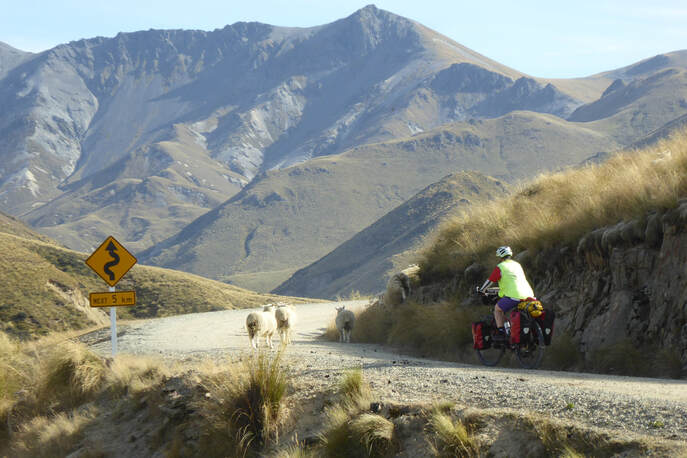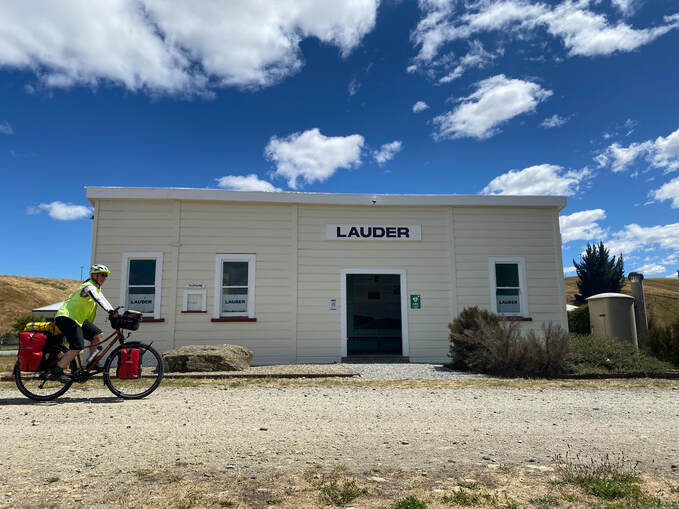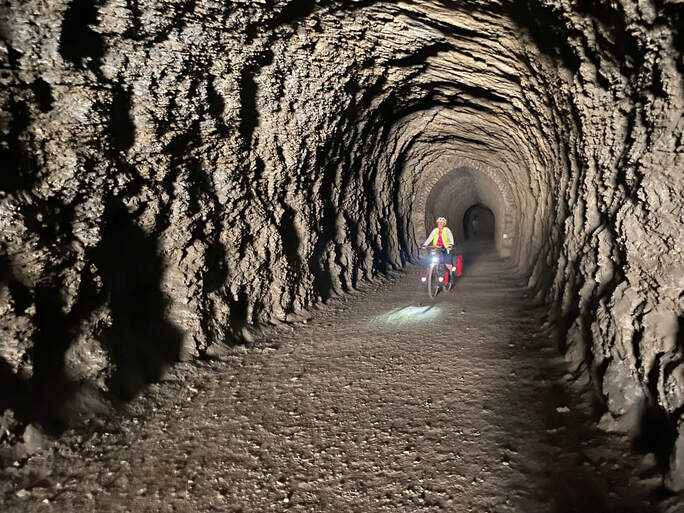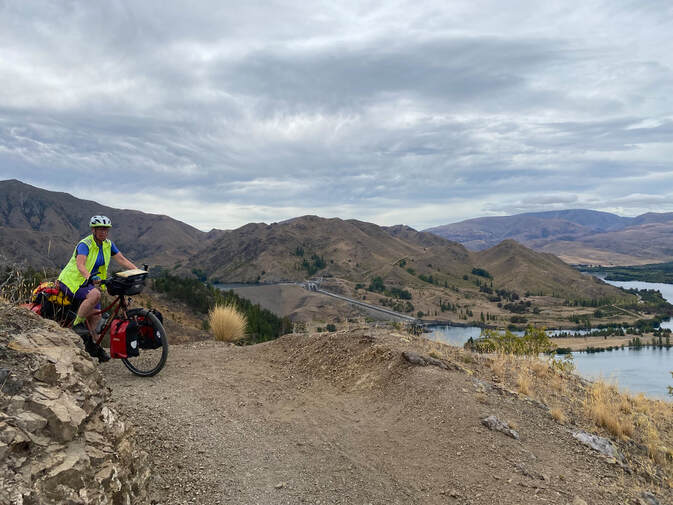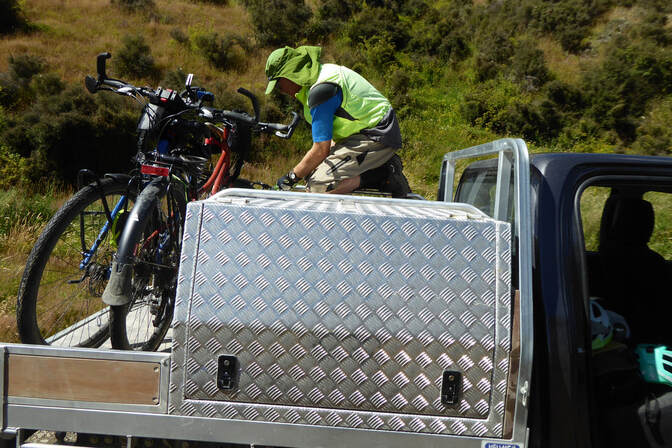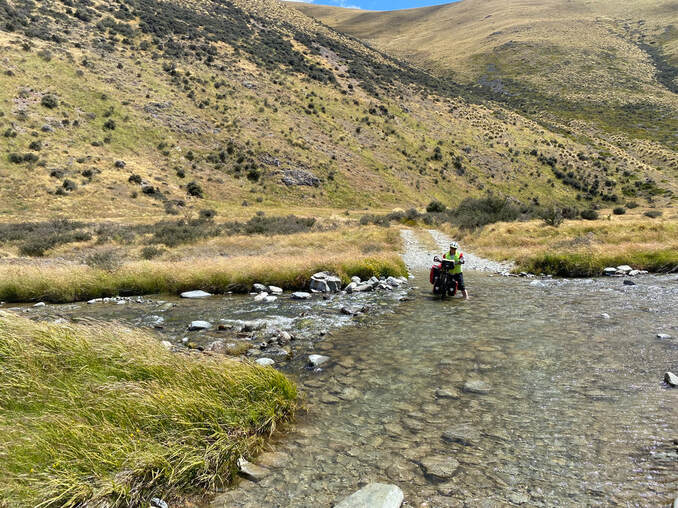Saddle Sore
2024.01.21
New Zealand - Canterbury and Central Otago
Maps & Photos
This article was written by Sharon and was first published in Daily Encourager.
Back country blows and blessings
Rail trails are typically flat, mountain passes are not. Combining both provided more action than leisure on our summer cycling trip.
Both the ups and downs encouraged us about what New Zealand is, and can be.
My husband Kel had devised a 400 km loop from the historic gold-mining village of Clyde, combining sections of the Otago Central Rail Trail and Alps 2 Ocean Cycle Trail (A2O) with gritty gravel mountain roads.
We set off in mid-January on our New Zealand-made Crucial Custom Cycles, which are touring bikes with mountain bike gears and thicker tyres.
Our food, water, clothes, camping stove, sleeping bags, tent, tools and first aid kit were packed into six panniers apiece. Little did we know that we’d really need the tools and first aid.
The first Otago Central Rail Trail day was glorious, riding through schist outcrops and rocky cuttings. Wild thyme and borage brought scent and colour to an arid landscape and hawks and falcons swooped overhead.
My husband Kel had devised a 400 km loop from the historic gold-mining village of Clyde, combining sections of the Otago Central Rail Trail and Alps 2 Ocean Cycle Trail (A2O) with gritty gravel mountain roads.
We set off in mid-January on our New Zealand-made Crucial Custom Cycles, which are touring bikes with mountain bike gears and thicker tyres.
Our food, water, clothes, camping stove, sleeping bags, tent, tools and first aid kit were packed into six panniers apiece. Little did we know that we’d really need the tools and first aid.
The first Otago Central Rail Trail day was glorious, riding through schist outcrops and rocky cuttings. Wild thyme and borage brought scent and colour to an arid landscape and hawks and falcons swooped overhead.
Rail trails have been railway lines in a previous life, so are usually fairly flat or undulating at the most, and this gravelled trail has a gentle 1:50 gradient.
For a time we cycled in sight of the Manuherikia River and this was not the last we’d see of it. However, we couldn’t see anything as we entered the first of two rail tunnels built early last century.
Our bikes’ dynamo hub-powered lights pointed the way but I felt like darkness was caving in on me, like I was fainting. I should have remembered – always remove your sunglasses before cycling through tunnels!
For a time we cycled in sight of the Manuherikia River and this was not the last we’d see of it. However, we couldn’t see anything as we entered the first of two rail tunnels built early last century.
Our bikes’ dynamo hub-powered lights pointed the way but I felt like darkness was caving in on me, like I was fainting. I should have remembered – always remove your sunglasses before cycling through tunnels!
Morning clouds had given way to hot sunshine as we stopped by the 37 m high, steel beam and rock buttressed Poolburn Viaduct to cook our spicy mince and salsa tortillas.
Entering the remote Ida Valley
After lunch we entered the remote Ida Valley, a medley of translucent wheat and irrigated green fields in front of distant dusky blue hills. The sound of wind played in macrocarpa.
As we pedalled, the lack of shade and heat of the day meant you could feel the heat. Like being inside a clothes dryer.
We slept at Wedderburn and the following day, left the trail for a leisurely day road cycling to another former gold-mining settlement, Naseby, then to Danseys Pass.
Kel and I slumbered in our tent at a Department of Conservation campsite, waking amid the silence only to admire brilliantly clear stars, which were like God’s generous lolly scramble.
We awoke at 6 a.m. to attempt the first serious climb of our ride: Danseys Pass, 32 km of gravel road cut through a spectacular Haast Schist mountain pass on the Otago-Canterbury boundary.
Fortunately, the weather wasn’t too hot and only about six vehicles passed us, all related to farming or conservation and driving considerately. The gravel was occasionally difficult but mostly compact.
Under a blue sky with light, white clouds, golden-green hills were sprinkled with crimson foxgloves and the dark greens and almost-purples of native bush.
As we ascended to the summit 920 m above sea level, all we could hear was a stream tinkling increasingly far below us and the maa-baa of sheep.
As we pedalled, the lack of shade and heat of the day meant you could feel the heat. Like being inside a clothes dryer.
We slept at Wedderburn and the following day, left the trail for a leisurely day road cycling to another former gold-mining settlement, Naseby, then to Danseys Pass.
Kel and I slumbered in our tent at a Department of Conservation campsite, waking amid the silence only to admire brilliantly clear stars, which were like God’s generous lolly scramble.
We awoke at 6 a.m. to attempt the first serious climb of our ride: Danseys Pass, 32 km of gravel road cut through a spectacular Haast Schist mountain pass on the Otago-Canterbury boundary.
Fortunately, the weather wasn’t too hot and only about six vehicles passed us, all related to farming or conservation and driving considerately. The gravel was occasionally difficult but mostly compact.
Under a blue sky with light, white clouds, golden-green hills were sprinkled with crimson foxgloves and the dark greens and almost-purples of native bush.
As we ascended to the summit 920 m above sea level, all we could hear was a stream tinkling increasingly far below us and the maa-baa of sheep.
A slow pleasant ascent
Our ascent involved painstaking pace but pleasant riding. We took about three hours to pedal 10 km to the summit, nestled among mountain tops and a high-tension power pylon.
After descending and cooking lunch while sitting on green grass splattered with sheep poo, beside a creek, we continued the rest of the next 10 km to Danseys Pass Lavender.
Unfortunately, Kel’s elevation graphic didn’t show a sudden 13 per cent ascent. It was very hard going and many times, he’d push-start me on the steep gravel road with a sharp drop to the right.
I couldn’t work out what was wrong, however once we’d discovered my brakes had overheated on the earlier descent and seized, it was plainer sailing. Or cycling.
Dark clouds turned to misty rain and it felt like we were pedalling through some Kiwi equivalent of the Wuthering Heights moors. Even the sheep had fallen silent.
After a night at the environmentally-friendly Danseys Pass Holiday Park, we spent two days alternating between roads and the A2O through Kurow, alongside Lake Aviemore, around Lake Benmore and into Ōmarama.
After descending and cooking lunch while sitting on green grass splattered with sheep poo, beside a creek, we continued the rest of the next 10 km to Danseys Pass Lavender.
Unfortunately, Kel’s elevation graphic didn’t show a sudden 13 per cent ascent. It was very hard going and many times, he’d push-start me on the steep gravel road with a sharp drop to the right.
I couldn’t work out what was wrong, however once we’d discovered my brakes had overheated on the earlier descent and seized, it was plainer sailing. Or cycling.
Dark clouds turned to misty rain and it felt like we were pedalling through some Kiwi equivalent of the Wuthering Heights moors. Even the sheep had fallen silent.
After a night at the environmentally-friendly Danseys Pass Holiday Park, we spent two days alternating between roads and the A2O through Kurow, alongside Lake Aviemore, around Lake Benmore and into Ōmarama.
A newer section of the A2O winds 16 km alongside Lake Benmore and offers beautiful views of deep, pristine water surrounded by barren mountains.
This section is off-road and the trail notes warn it is narrow in places and has many fall hazards. I’d say it is only suitable for cyclists who are confident on shingle and rocks, or willing to walk sometimes.
That said, the scenery was among the best I’ve seen on South Island bike trails and the variety of riding, either high above or closer to the lake, made it utterly worthwhile.
After sleeping in Ōmarama, we woke at 5 a.m. for what we knew would be our most challenging mountain pass of the trip: the Ōmarama Saddle.
And challenging it turned out to be. Rain fell consistently as we rode through farmland and alpine tussock on the West Manuherikia Track in the Oteake Conservation Park.
This section is off-road and the trail notes warn it is narrow in places and has many fall hazards. I’d say it is only suitable for cyclists who are confident on shingle and rocks, or willing to walk sometimes.
That said, the scenery was among the best I’ve seen on South Island bike trails and the variety of riding, either high above or closer to the lake, made it utterly worthwhile.
After sleeping in Ōmarama, we woke at 5 a.m. for what we knew would be our most challenging mountain pass of the trip: the Ōmarama Saddle.
And challenging it turned out to be. Rain fell consistently as we rode through farmland and alpine tussock on the West Manuherikia Track in the Oteake Conservation Park.
Rain and muddy puddles
Rain wasn’t the issue, although the resulting muddy puddles later were. Before that, though, Kel’s chain broke for the first time in more than 25,000 km of tour cycling.
Out came his tool kit and with the help of two couples who stopped in their four-wheel drives (4WD), we were soon on our way.
We’d already planned to trudge the last 4 km of this rough 4WD track to the 1260 m summit and the weakened chain lengthened this to 5 km.
As we began walking our bikes, Ash from Fairlie pulled up in his 4WD and offered to drive us to the summit, which was a huge help. He left us atop the very windy Ōmarama Saddle and Kel rode the next stony, steep 2 km downhill. I walked.
Out came his tool kit and with the help of two couples who stopped in their four-wheel drives (4WD), we were soon on our way.
We’d already planned to trudge the last 4 km of this rough 4WD track to the 1260 m summit and the weakened chain lengthened this to 5 km.
As we began walking our bikes, Ash from Fairlie pulled up in his 4WD and offered to drive us to the summit, which was a huge help. He left us atop the very windy Ōmarama Saddle and Kel rode the next stony, steep 2 km downhill. I walked.
After cooking a freeze-dried lunch at Top Hut, we continued cycling, knowing we would have 32 river crossings as we gently descended long, remote alpine valleys, the sun playing chase with the clouds.
It was the Manuherikia River again. Crossing it was refreshing and not problematic. But it was on the rough stone, grass ridge and muddy puddle track that I slipped off my bike, intending to plant both feet on the ground.
This was a controlled slip like I’ve done many times, however I misjudged probably the murky puddle and lost my footing. My pannier-laden bike fell on to my left leg, trapping it and painfully twisting my knee.
Thankfully, after initial pain, there was only discomfort. Kel bandaged my knee and I could still walk – not pedal, because the joint kept giving way.
Thankfully too, after I’d walked about 2 km, Jean-Luc turned up in his 4WD and transported our panniers and myself to the next hut, while Kel rode both bikes. We spent an unplanned night at Boundary Creek Hut, grateful for our contingency rations.
It was the Manuherikia River again. Crossing it was refreshing and not problematic. But it was on the rough stone, grass ridge and muddy puddle track that I slipped off my bike, intending to plant both feet on the ground.
This was a controlled slip like I’ve done many times, however I misjudged probably the murky puddle and lost my footing. My pannier-laden bike fell on to my left leg, trapping it and painfully twisting my knee.
Thankfully, after initial pain, there was only discomfort. Kel bandaged my knee and I could still walk – not pedal, because the joint kept giving way.
Thankfully too, after I’d walked about 2 km, Jean-Luc turned up in his 4WD and transported our panniers and myself to the next hut, while Kel rode both bikes. We spent an unplanned night at Boundary Creek Hut, grateful for our contingency rations.
We emerged the next morning to a flat tyre on my bike. Out came the pump. Although Kel could ride, I still couldn’t because my swollen, stiff knee wouldn’t allow my leg to reach the pedal.
An answer to prayer
We managed about 2 km but the sun was getting hotter and my cautious walking was slower than cycling. We had plenty of food and water and I wasn’t seriously injured but it was going to be a long, hot, difficult day. My tyre went flat again and Kel changed the tube. I let out a prayer.
Within five minutes, two 4WDs arrived, one of them our fellow hut-sleepers and the other Ben and his son from Portobello, Dunedin.
Between them, they kindly transported me, my bike and our panniers to Homestead Campsite. Kel took off on his “naked bike”, intending to cycle 18 km to St Bathans, catch a ride to Clyde and drive back to pick me up.
I settled in the campsite shelter for a long, quiet day of waiting.
Thankfully, though, on the still-remote gravel road, Kel met Nathan from Becks, who generously drove us and all our gear to St Bathans, then a further 61 km to Clyde.
I arrived in Clyde tired, relieved and grateful. And with an understanding of how different it had been in that back country.
It was like people watched out for each other. It reminded me of tramping, or crises caused by natural disasters or pandemics. It reminded me of the way New Zealand used to be, but also of the way it is and can be.
Within five minutes, two 4WDs arrived, one of them our fellow hut-sleepers and the other Ben and his son from Portobello, Dunedin.
Between them, they kindly transported me, my bike and our panniers to Homestead Campsite. Kel took off on his “naked bike”, intending to cycle 18 km to St Bathans, catch a ride to Clyde and drive back to pick me up.
I settled in the campsite shelter for a long, quiet day of waiting.
Thankfully, though, on the still-remote gravel road, Kel met Nathan from Becks, who generously drove us and all our gear to St Bathans, then a further 61 km to Clyde.
I arrived in Clyde tired, relieved and grateful. And with an understanding of how different it had been in that back country.
It was like people watched out for each other. It reminded me of tramping, or crises caused by natural disasters or pandemics. It reminded me of the way New Zealand used to be, but also of the way it is and can be.
If you liked this story, join our Daily Encourager Media Facebook page by clicking here
For further information:
Otago Central Rail Trail
Alps 2 Ocean Cycle Trail
Naseby
Department of Conservation’s West Manuherikia Track
For further information:
Otago Central Rail Trail
Alps 2 Ocean Cycle Trail
Naseby
Department of Conservation’s West Manuherikia Track
Sharon and Kel Fowler began tour cycling 15 years ago while living in Europe, where they’ve toured extensively. In 2017, they rode 8000 km from the west coast of the United States to Canada’s east coast. Since returning to New Zealand, they have ridden six annual road trips in the South Island.
You can read more of their cycling adventures below:
Riding the mountain of delights
Riders in the storm
Gritty, gravelly and gorgeous
Powering the MacKenzie
Of popping tar-seal and ginger beer
Rescued by kindness
Riding the mountain of delights
Riders in the storm
Gritty, gravelly and gorgeous
Powering the MacKenzie
Of popping tar-seal and ginger beer
Rescued by kindness

